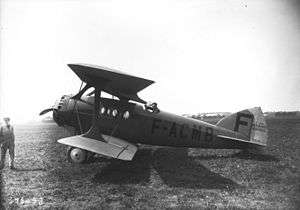Blériot-SPAD S.33
| Blériot-SPAD S.33 | |
|---|---|
 | |
| Role | Airliner |
| Manufacturer | Blériot |
| First flight | 12 December 1920 |
| Primary users | Franco-Roumaine, CMA SNETA |
| Number built | ca. 41 |
| Variants | Blériot-SPAD S.46 |
The Bleriot-SPAD S.33 was a small French airliner developed soon after World War I. A great success, the S.33 dominated its field throughout the 1920s, initially on CMA's Paris-London route, and later on continental routes serviced by Franco-Roumaine. The aircraft was a biplane of conventional configuration whose design owed much to the Blériot company's contemporary fighter designs such as the S.20. Four passengers could be accommodated in an enclosed cabin within the monocoque fuselage, and a fifth passenger could ride in the open cockpit beside the pilot.
One interesting development was a sole example converted by CIDNA to act as a blind-flying trainer. A set of controls was installed inside the passenger cabin, the windows of which had been blacked out.
Variants
- S.33
- Single-engined passenger transport aircraft, powered by a 260 hp (190 kW) Salmson CM.9 radial piston engine. 41 aircraft built.
- S.46
- Improved version of the S.33, powered by a 370 hp (280 kW) Lorraine-Dietrich 12Da engine. 38 built and sold to the Franco-Roumaine Company.
- S.48
- A single S.33 temporarily re-engined in 1925, fitted with a 275 hp (205 kW) Lorraine 7M Mizar engine.
- S.50
- Luxury version with passenger cabin enlarged to six seats, fitted with a 300 hp (220 kW) Hispano-Suiza 8Fb engine. Three were converted from S.33s, plus two all-new aircraft.
Operators
- Franco-Roumaine (20 aircraft)
- CMA (15 aircraft)
- SNETA (6 aircraft)
Specifications (S.33)
General characteristics
- Crew: one pilot
- Capacity: 5 passengers
- Length: 9.08 m (29 ft 10 in)
- Wingspan: 11.66 m (38 ft 3 in)
- Height: 3.20 m (10 ft 6 in)
- Wing area: 42.2 m2 (454 ft2)
- Empty weight: 1,050 kg (2,315 lb)
- Gross weight: 2,062 kg (4,546 lb)
- Powerplant: 1 × Salmson CM.9 water-cooled radial engine, 194 kW (260 hp)
Performance
- Maximum speed: 180 km/h (112 mph)
- Cruising speed: 160 km/h (100 mph)
- Range: 1,060 km (670 miles)
- Service ceiling: 3,800 m (12,470 ft)
See also
- Related development
References
- Taylor, Michael J. H. (1989). Jane's Encyclopedia of Aviation. London: Studio Editions. p. 163.
- World Aircraft Information Files. London: Bright Star Publishing. pp. File 890 Sheet 42.
- aviafrance.com
External links
| Wikimedia Commons has media related to Blériot-SPAD S.33. |
- "The Spad "Berline" S.33 bis" (PDF). Flight. XIII (27): 460–462. 7 July 1921. No. 654. Retrieved 26 April 2012. Contemporary technical description of the Blériot-SPAD S.33, including photographs and drawings.